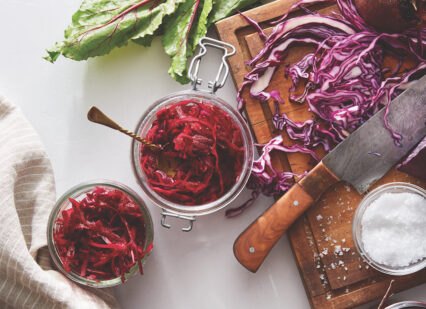Mindful Eating: The Benefits and How to Start
Getty/sveta_zarzamora
Mindful eating means being intentional about what, when, and how you eat. It can become more intuitive the more you practice.
Benefits of Mindful Eating
- Reduces binge eating and emotional eating
- Improves digestion
- Increases satisfaction and satiety
- Acts as an innate form of portion control
- Leads to more sustainable weight loss
- Creates a healthier relationship with food
- Generates body awareness and acceptance
- Honors body wisdom
Number-one reason to eat mindfully: It makes eating more enjoyable!
Mindful Eating Basics: Sit. Breathe. See. Smell. Taste. Chew. Savor. Enjoy.
A few years ago, I went to a Vipassana ten-day silent meditation retreat. Once I had committed, almost blindly I might add, I started reading through the information about what to expect on this journey to enlightenment. What really caught my attention was that we would be served vegan meals (fine by me!), and we would eat only two meals a day, breakfast and lunch. One could enjoy tea and fruit in the evening if desired (I think that’s how they put it in the course description).
I panicked.
I’m a person who eats five to six times a day, so this was bringing up food insecurities, concerns about my health and well-being, worries about blood sugar plummeting, and maybe even fainting spells from starvation. My mind was creating some pretty bizarre scenarios, and I even contemplated having one of my doctor friends write a note so that I could be allowed snacks. Oddly, I didn’t spend any time thinking about how difficult it would be to sit in meditation for ten hours a day for ten days straight without talking to a soul. This tells you how food obsessed I really was!
When I arrived onsite the first night, we were allowed to talk to our fellow Vipassana companions and get acquainted with our roommates. My roommate was from Colorado and also seemed to be worried about the food situation but in a very different way. She put a big bottle of Tums on our bathroom counter and told me I could help myself. “I hear the menu has a lot of roughage, so we might need these,” she told me. I didn’t have the heart to tell her this is the way I eat at home and having someone else cook this kind of food for me was a dream come true. I just thanked her and smiled.
Every morning there was a serve-yourself oatmeal bar, which consisted of a huge pot of oatmeal and a row of small bowls of nuts, seeds, dried fruit, sweeteners like honey and brown sugar, milk alternatives, and bananas. We were to dish up our oatmeal, choose our toppings, and sit in the dining hall in noble silence (meaning you also refrain from staring people down while not talking to them). We had one hour from when they would strike the breakfast gong to the time we were to report to the meditation hall. The first day I finished my oatmeal in ten minutes and then walked around in circles in the rain for fifty minutes, probably planning my escape.
As the days wore on, I became proficient at savoring that bowl of oatmeal for almost an entire hour. I took my time making very deliberate choices with my toppings, I roamed about until I found the perfect spot looking out into the meadow where the deer were grazing. I set my place and gave thanks to the many people who were volunteering their time to create this whole experience for us. And then I ate . . . so. very. slowly. I really had no idea you can keep oatmeal in your mouth for that long. I can still recall the texture of the oats, peanut butter, and banana on my tongue, and I can smell the fresh ground peanut butter. I can hear the person next to me chewing louder than I liked. I remember how comforting it felt to have that morning routine.
By the way, my food scarcity fears were completely unwarranted and went away by the second day, when I realized that your energy requirements go down pretty significantly when you’re just sitting in meditation for most of your day. I learned many valuable lessons, not the least of which was that, if I could eat oatmeal for an entire hour, I sure as hell could sit down and savor my breakfast for fifteen minutes in the morning before work.
Intuitive Eating or Mindful Eating?
There are a variety of different views on intuitive eating. One school of thought says your body will self-regulate as long as you’re not imposing any restrictions. So if you feel like eating ice cream, dig in! Keep eating until you no longer have the urge.
But what if you just don’t lose the urge? In fact, maybe the urge just keeps getting stronger. While I’m a fan of the concept of intuitive eating, I worry that our food supply has become so highly processed and sugar-laden that we’re being manipulated by ingredient combinations that keep us forever craving and never feeling satisfied.
The other challenge with intuitive eating is that a body that is overfed and undernourished does not produce reliable hunger and satiety cues, so succumbing to the craving of the moment because your mind tells you that your body wants and deserves it is not the same as feeling the sensory experience of hunger and feeding yourself accordingly. You can definitely get to a place where you can trust that the cues you’re receiving are legitimate, but if you’re engaging in mindless eating and binge-like behaviors, the reliability factor is pretty compromised.
Energy Flows Where Intention Goes
I like to describe mindful eating as intentional eating. And this way of eating will become more intuitive after the body restores itself to its natural homeodynamic state. Eating with intention requires some planning and preparation, but the payoff is huge and you’ll quickly discover that as you begin to eliminate the power struggle with food. You’ll feel your energy improve, your mind will become clear and focused, your body will feel lighter and more agile. Planning and prep become less cumbersome as you start feeling better and the benefits of your work become abundantly clear.
If you’re struggling with fatigue or low energy you may have to fake it ’til you make it. Set up the structure, stick to the plan, and trust that you’ll end up with more fuel in the tank to further your journey down the road to wellness. You can also take shortcuts with no apologies. There are plenty of ways in which you can get nourishing food in front of you, even if you don’t have the energy to do a lot of food prep and cooking. There are lots of precut veggies now in the produce section, some decent frozen meals with recognizable ingredients, natural foods markets with salad bars and healthy deli options, meal delivery services, and even personal chef options if you have the financial resources. Don’t let an energy deficit or lack of enthusiasm about cooking stop you from becoming the mindful, intentional eater you deserve to be.
Consider for a moment how much we require and expect from our bodies. We want to maintain a healthy weight, be active, have good energy, feel sexy, be productive, have good digestion, have a strong immune system, think clearly, sleep well, and wake up energized every morning. Now ask yourself how much you’re willing to put into the system to realize those expectations. Is it reasonable to expect complete cooperation from your body if you’re unable to find the time to simply feed yourself regularly and with intention throughout the day?
I get that we’re overscheduled and overcommitted and there are never enough hours in the day. But now might be the time to evaluate with brutal honesty what has to give in order for you to be able to form a more productive partnership with your body and put enough energy into the system to get the returns you so badly desire
©2020 by Michelle Babb. Excerpted from Mastering Mindful Eating by permission of Sasquatch Books.
You might also enjoy “16 Affirmations for Mindful Eating.”
Pumpkin Pie Granola
A simple, home-baked creation that will fill your home with the scent of Fall. [Get the recipe]
Crimson Beets and Purple Cabbage Kraut
Add this colorful and tangy kraut to your salad or stir fry and your taste buds, and gut, will be singing. [Get the recipe]




